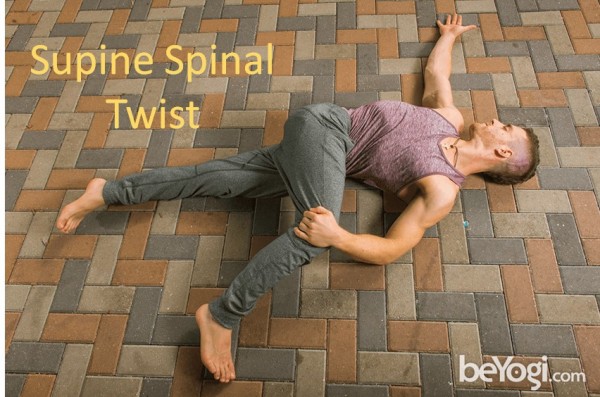
Supine Spinal Twist
If you are suffering from back pain or having problem with digestion then performing supine spinal twist pose helps. It stretches back muscles along with spine. It also stimulates abdominal organs, kidneys, bladder and intestine. It is a basic yoga pose and helps in releasing stress. When we twist opposite to our bending knee, it also helps to release the hamstrings and strengthens thighs. Performing supine spinal twist two to three times a day helps in giving flexibility to entire abdominal region and refreshes back muscles. – Healthy Life
LEVEL: Beginner
Anatomy: Glutes, Hips, Spine
Pose Type: Resting, Supine, Twist
Sanskrit: Supta Matsyendrasana, (soop-TAH MOTS-yen-DRAHS-anah), supta = supine, reclined
matsya = fish, indra = ruler
BENEFITS
- Lengthens the spine and hip external rotators
- Detoxifies internal organs and massages abdominal tissues
- Improves spinal flexibility
- Balances sacroiliac joints
- Improves digestion
- Relieves pain in the low back, spine, and hips
CONTRAINDICATIONS
- Hip pathologies
- Limited hip range of motion
- Low back pathologies (avoid rounding)
- Gastrointestinal issues or hernia
HOW TO
- Gently recline down onto your back.
- Inhale and engage your core. Bend your right leg and draw the knee to your chest, letting your shoulder blades settle onto the mat.
- As you exhale, draw your right knee across the left side of your body. Allow the spine to gently rotate, placing your left hand on top of your right knee for support. Rest your bent knee on the ground, so your right thigh aligns with your hips.
- Inhale and extend your right arm out to the side, at shoulder height, with your palm facing up.
- Feel free to draw your gaze toward the open arm to deepen the stretch.
- Hold this pose for up to 10 slow breaths.
- To exit, inhale and release onto your back. Exhale and extend the right leg; then repeat on the opposite leg.
MODIFY OR REPLACE
- Feel free to place a block under the knee for support.
- Draw both knees together and slowly rotate to the side.
SEQUENCING TIPS
Before:
- Pavanamuktasana (Knees to Chest pose)
- Ananda Balasana (Happy Baby pose)
- Ardha Pavanamuktasana (Knee to Chest pose)
- Utthita Hasta Padangustasana (Extended Big Toe pose)
After:
- Supta Vrkasana (Supine Tree pose)
- Supta Baddha Konasana (Supine Bound Angle)
TEACHING CUES
- On each inhale, reach through the extended arm and the bent knee in opposite directions.
- On each exhale, work toward rolling your entire ribcage to the mat to ground the shoulders.
- Bring your knee toward your chest, and slowly draw it across the body.
- You should not feel anything sharp or shooting; if so, back off the stretch or release the posture.
VARIATIONS
- Jathara Parivartanasana (Belly Twist pose)
- Jathara Parivartanasana with extended leg
WATCH OUT FOR
- Low back lifting off the floor
- Shoulders lifting off the floor
- Spinal pain or strain
This article and image is published here with permission from www.beyogi.com
Author: HealthyLife | Posted on: February 9, 2018






















Write a comment